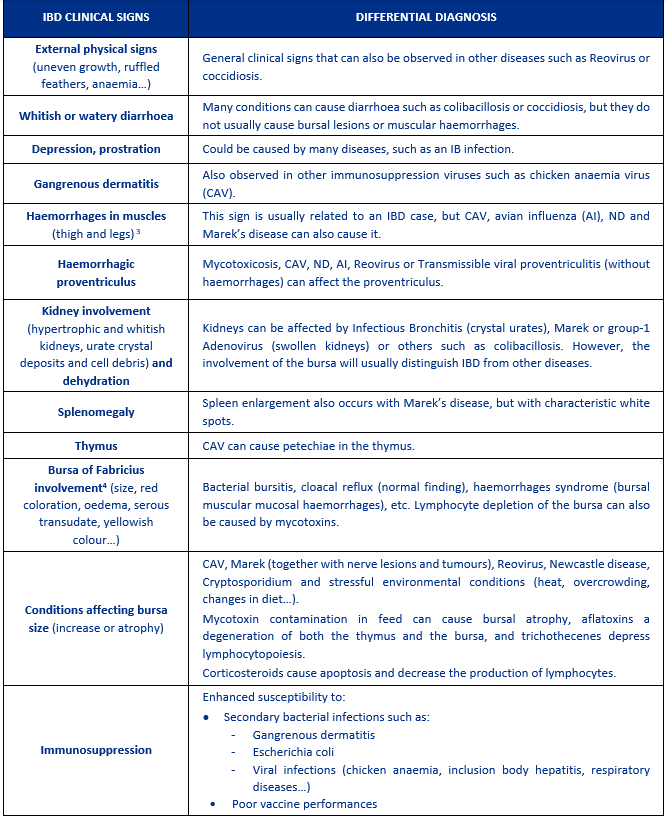The diagnosis of Infectious bursal disease (IBD) is not always obvious if we rely only on the clinical signs observed. The main reason for this is that there are several pathologies that share similar clinical signs and, on the other hand, there is a clear tendency towards subclinical IBD strains, which present very few or even no clinical IBD symptoms. For this reason, it is important to correctly carry out a differential diagnosis of the disease together with laboratory diagnostic techniques to confirm IBDV involvement in the farm situation.

Gumboro disease was initially described as avian nephrosis due to damage caused in the kidneys1 but was later named Infectious bursal disease (IBD) based on the morphologic and histological changes observed in its target organ, the bursa of Fabricius.
Clinical IBD is responsible for heavy economic losses due to impaired growth, death, carcass condemnation and losses due to immunosuppression. IBD symptoms and postmortem findings may help to diagnose IBD, but laboratory diagnosis is required for final confirmation.2
The disease presents several general clinical signs, but what characterizes it most are the changes observed in the bursa of Fabricius, making it a very useful tool to confirm an IBD outbreak. Even so, a differential diagnosis must be considered since similar lesions can be found in other pathologies.
Reovirus, Newcastle disease (ND) in its visceral forms, mycotoxicosis, chicken anaemia virus (CAV) and nephrogenic forms of infectious bronchitis (IB) are the main differential diagnoses for IBD
The following table describes some of the IBD symptoms in poultry along with other compatible pathologies that should be considered in the differential diagnosis:
Laboratory diagnostic techniques such as serology, PCR and histopathology of the bursa will allow the final differentiation between IBD and other diseases.
The video reviews the key points in a necropsy focused on IBDV. Mar Biarnés (CESAC Technical Director) evaluates the affected organs, differential diagnosis, sample collection and resolution of real cases of IBDV from the necropsy and diagnostic perspective.
Bibliography
1. Cosgrove AS. An apparently new disease of chickens: Avian nephrosis. Avian Diseases. 1962; 6: 385-387.
2. Banda A. Characterization of Field Strains of Infectious Bursal Disease Virus (IBDV) Using Molecular Techniques. Athens, Georgia, USA: University of Georgia; 2002.
3. Tesfaheywet Z, Hair-Bejo M, Rasedee A. Hemorrhagic and clotting abnormalities in infectious bursal disease in specificpathogen- free chicks. World Appl Sci J. 2012; 16: 1123-1130.
4. Islam MT, Samad MA. Clinico-pathological studies on natural and experimental infectious bursal disease in broiler chickens. Bangladesh Journal of Veterinary Medicine. 2014; 2: 31-35.

